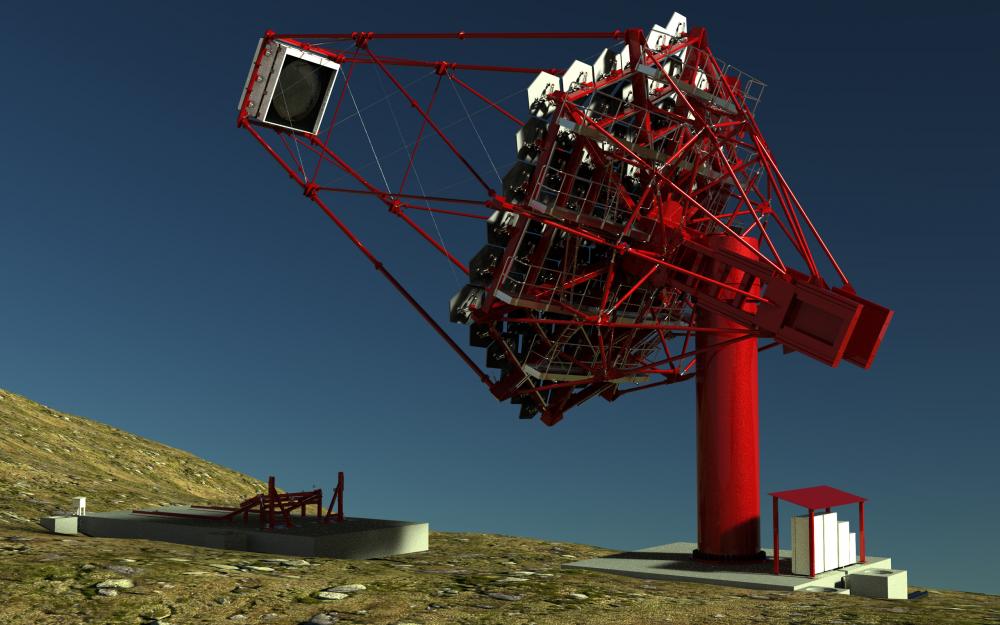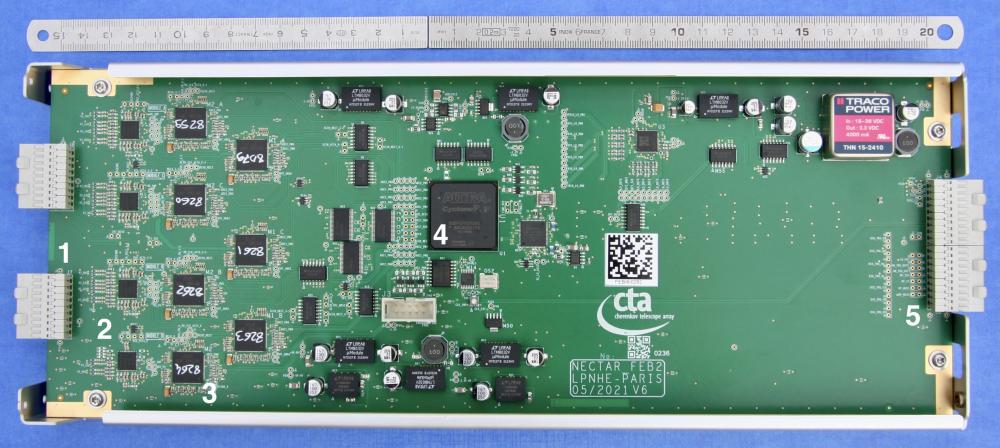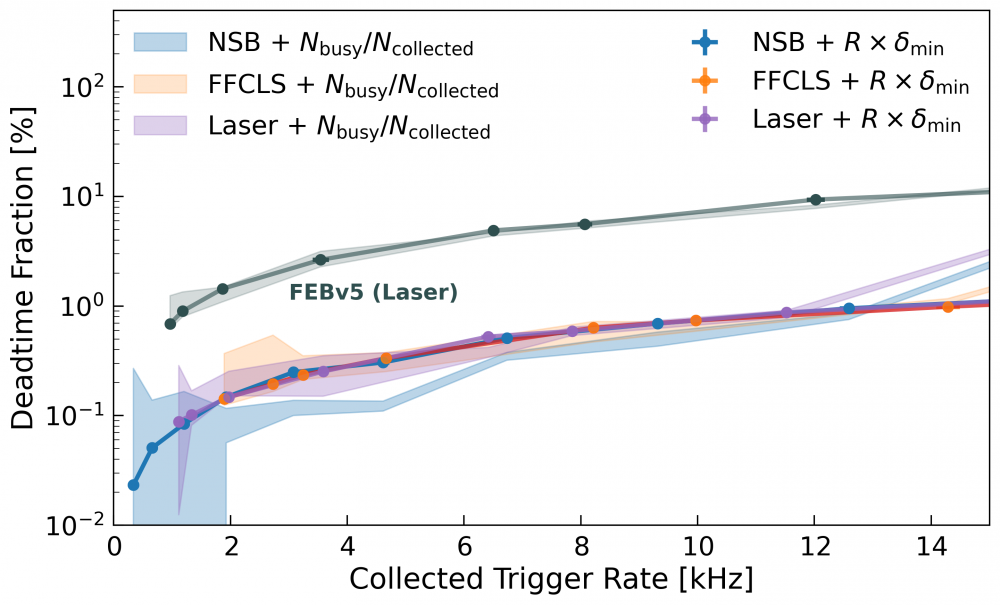
Figure 1: Rendering image of the Medium Size Telescope for CTAO. The NectarCAM camera is going to equip the 9 MSTs to be installed in the North site of CTAO in La Palma (Spain). (credits: Oscar Ferreira/NECTARCAM Collaboration)
In the quest to unravel the mysteries of the Universe, astrophysicists and engineers are pushing the boundaries of technology to capture the fleeting signals of cosmic events. Leading this big effort is the Cherenkov Telescope Array Observatory (CTAO), a global initiative to build the world's most advanced ground-based gamma-ray observatory. CTAO will use three different sizes of telescopes – large, medium, and small – to cover an unprecedented energy range between 20 GeV and 300 TeV and be installed in two sites on Earth – Chile and the Canary Islands – to cover the full sky. Central to the operation of CTAO's medium-sized telescopes at the Northern site is the NectarCAM camera, equipped with a critical component known as the Front-End Board (FEB). Advancements in the FEB since 2020, featuring the integration of the cutting-edge NECTAr3 chip developed at IRFU, mark a significant leap forward in our quest to observe the cosmos with unprecedented clarity and efficiency. The new chip has improved the camera's deadtime by an order of magnitude, increasing the rate at which the camera can work and lowering the energy threshold of detectable gamma rays. In this work published in NIM-A in April 2024, the new FEB and NECTAr3 chip are described, as well as the tests performed at IRFU to verify the improved performance of the camera in terms of deadtime, linearity, and timing precision.
A new NECTAr chip for the latest front-end-board (FEB)
The NectarCAM camera acts as the observatory's eyes, capturing brief yet brilliant flashes of Cherenkov light produced when high-energy gamma rays collide with the Earth's atmosphere. This fleeting light unveils the violent processes occurring across the galaxy and beyond, from supernovae explosions to the enigmatic behavior of black holes. At the heart of NectarCAM, the Front-End Board (FEB) translates these light signals into digital data for scientists to analyze.
When Cherenkov light impinges on the camera, it is first collected by photomultiplier tubes – 1855 in total for one NectarCAM. These detectors convert the faint light into electrical signals, amplifying them into two gain channels. These signals are then sent to the FEB, which performs a second amplification, sampling, digitization, and recording. Central to the FEB is the NECTAr chip, developed at IRFU, which includes a switched capacitor array for sampling signals at 1 GHz and a 12-bit analog-to-digital converter (ADC) for digitizing these signals upon receiving a trigger. A key advancement of the NECTAr chip is its capability to operate in 'ping-pong mode'.
In this mode, the chip's memory is divided into two segments that operate alternately to optimize the processing of incoming analog signals, addressing the issue of deadtime— the period during which the system cannot record new data while processing the current signal. Traditionally, the capture and processing of a signal prevent the system from accepting a new signal, leading to deadtime. This limitation reduces the system's efficiency, especially when observing high-frequency astronomical phenomena. The 'ping-pong mode' alleviates this by utilizing a dual-buffer system. While one buffer processes a signal, the second buffer stands ready to capture the next incoming signal. This alternating operation ensures continuous data acquisition, significantly reducing the system's deadtime. Upon a trigger event, the active buffer freezes to process the data, while the alternate buffer immediately begins data acquisition. This method minimizes the intervals during which the system cannot record new events—referred to as the minimum deadtime—thereby enhancing the trigger rate and enabling more continuous and efficient observation of variable cosmic events.

Figure 2: New Front-End-Board of NectarCAM. The main components are indicated by numbers. 1: Left connectors through which the electrical signals from 7 PMTs arrive at the board. 2: Four ACTA amplifiers. 3: Seven NECTAr3 chips. 4: FPGA. 5: Right connector, which serves as the mechanical and electrical interface to the board responsible for the creation of the camera trigger. (credits: Vincent Marandon/IRFU/CEA)
|
NECTAr is a chip developed at IRFU, capable of capturing at a high sampling rate (109 samples per second) the analogue transient waveform as delivered by the photomultiplier and storing it until a read request after system triggering. The device is based on a patented analogue memory structure, which allows for a reduction in power consumption by a factor of 100 compared with standard systems. This structure was originally employed in the SAM chip, designed for the purpose of reading the HESS CT5 large telescope. NECTAr was developed specifically for CTA as part of an ANR project funded in 2009 as an upgrade of SAM, integrating an analogue-to-digital converter, a four times larger memory array to cope with longer trigger latencies, and a faster readout system that allows a 60-sample frame to be read in less than 6µs. The first version of the NECTAr chip is currently used by the four H.E.S.S. upgrade cameras installed in 2016. The addition of the ping-pong mode in the NECTAr3 chip does not change the readout time, but improves the dead time. |
A reduced deadtime with ping-pong mode
The NectarCAM team at IRFU has conducted a series of tests to evaluate the performance of the new FEBs, focusing particularly on measuring the camera's deadtime. These tests were carried out in the darkroom at IRFU, a thermally controlled environment shielded from external light sources, where the NectarCAM camera undergoes testing before being shipped to the Canary Islands. With a surface of ~80 m2, it was specifically built for the NectarCAM project[1] and was partly funded by a DIM ACAV grant, to test the 9 cameras before mounting them on site in La Palma. To simulate the light that the camera will encounter once installed on the telescope structure, three distinct light sources were used: a Flat Fielding Calibration Light Source (FFCLS), a laser, and a Night Sky Background (NSB) source. The FFCLS employs 13 LEDs to provide a uniformly illuminated field to the camera, serving as a benchmark for identifying and correcting spatial variations in the camera's response. Capturing images with this source enables the detection of sensitivity discrepancies across the camera's detector. The laser, being a more precise light source, is suited for exact timing measurements. Meanwhile, the NSB source replicates the natural ambient light of the night sky. All three sources were employed to illuminate the camera randomly by employing a generator able to reproduce a physical trigger that arrives randomly in time.
During these tests, the number of times that the camera was illuminated (Ncollected) was recorded, along with instances where the camera was unable to record new light signals because it was already occupied digitizing another signal (Nbusy). By comparing these two rates, an estimation of the deadtime fraction was derived, which indicates the camera's "dead" state, rendering it incapable of recording a signal.
Additionally, a second method was employed to cross-check the deadtime fraction. When a signal is recorded by the camera, an event is created and a time-stamp is assigned to it. Given the random nature of the light emission, the distribution of the time difference between consecutive events resembles an exponential distribution. This distribution was fitted with a truncated exponential model, whose parameters include the minimum deadtime (δmin) and the exponential rate (R). The minimum deadtime denotes the shortest interval between two events as dictated by the NECTAr chip, approximately 700 ns, while the exponential rate reflects the event recording rate. The deadtime fraction, in this case, is determined by multiplying the minimum deadtime by the rate.
Figure 3 presents the principal findings from the deadtime measurements. The data for the new FEB version is depicted using colored lines, contrasting with the gray lines representing data from the previous FEB version (v5). Different colors correspond to the various light sources utilized in the measurements. Solid lines and shaded areas denote the two methods applied to calculate the deadtime fraction. The results illustrate that the newly introduced ping-pong mode significantly reduces the deadtime fraction to 0.5% at the standard operation rate on the sky of 7 kHz, marking a tenfold improvement.

Figure 3: Deadtime fraction for the new FEBs (in color) and the old FEBs v5 (in gray). The deadtime fraction estimated by the ratio between the busy trigger rate and the total trigger rate (filled area) is compared with that obtained from the exponential fit (dots and solid line). All the three sources are shown: the FFCLS (in orange), the laser source (violet) and the NSB source (blue).
Thanks to the work of engineers and researchers at IRFU, among others, the NectarCAM camera is now fully assembled on the testbench at IRFU. Major tests are underway to verify its performance and ensure readiness for installation on-site to capture data from the sky. Among these tests is the validation of the cutting-edge, upgraded NECTAr chip developed at IRFU. This upgrade represents a significant milestone for NectarCAM and CTA. Thanks to the improved capabilities of NectarCAM, we are equipped to capture the transient phenomena of the cosmos at higher rates and lower energies. This means we'll be able to uncover new secrets of the universe, opening up new possibilities for discovery and understanding the cosmos in ways we never imagined.
What's on the horizon? The next major step involves mounting the camera on the Medium-Sized Telescopes (MST) at the La Palma site and subsequent observations, scheduled for the the end of 2025, and starting the production and integration of the remaining eight ones at the end of 2024. So, get ready to explore the universe with NectarCAM's new and improved eye on the sky. The next chapter in cosmic exploration is just beginning, and it's brighter and clearer than ever!
Authors: F. Bradascio, E. Delagnes (J.F. Glicenstein)



